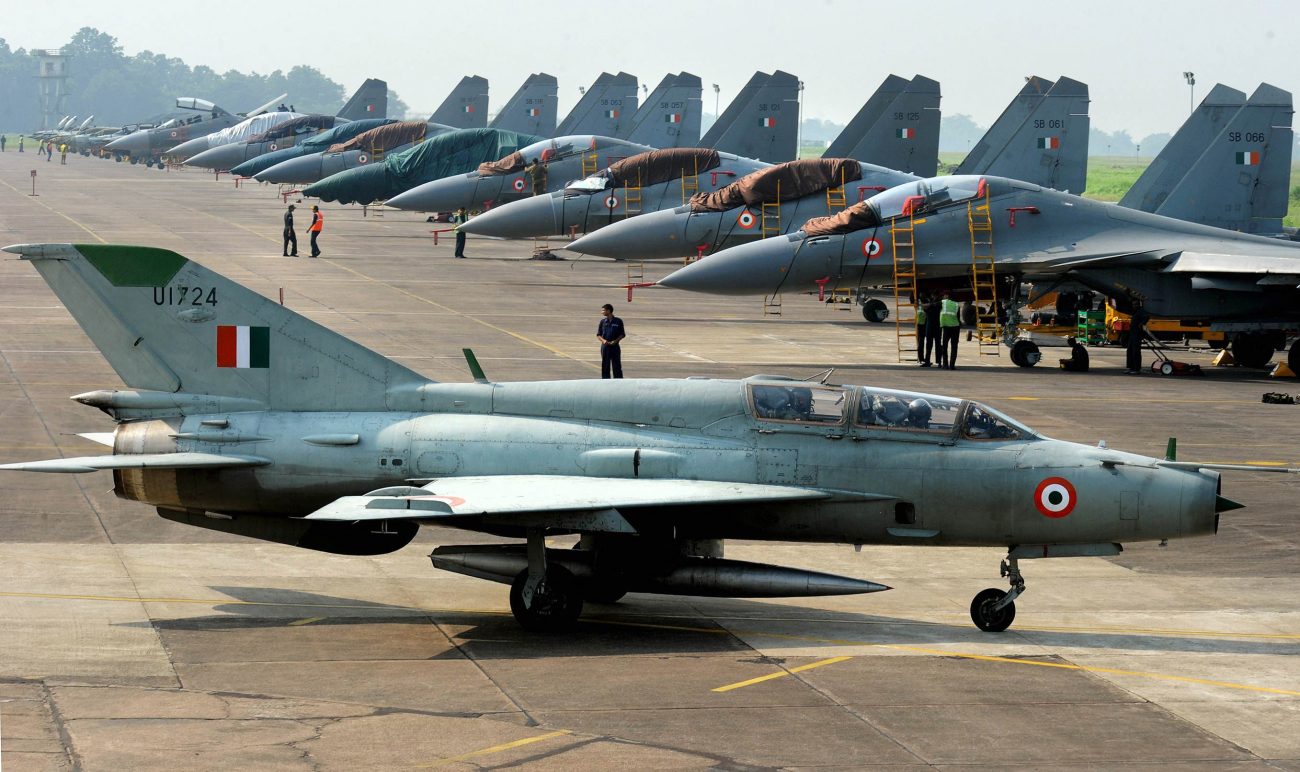India is a land of contradictions. According to the Global Firepower Index 2025, India has the world’s fourth most powerful Air Force after the US, Russia, and China, maintaining a formidable fleet of 2,229 aircraft, including over 500 fighter jets.
Despite these impressive numbers, India also has the unenviable position of having one of the highest aircraft accident rates during peacetime in Asia.
The Indian Air Force (IAF) has lost five aircraft so far in 2025 in peacetime operations: three Jaguars, one Mirage-2000, and one Antonov An-32. IAF also lost some jets during the brief four-day war with Pakistan in May.
In fact, Pakistan, India’s archenemy, whose Air Force is ranked seventh on the Global Firepower Index, claims that it has consistently outperformed the IAF during the last three clashes.
While Pakistani claims must be taken not just with a pinch of salt but a handful of salt, it can’t be denied that Islamabad has scored a point or two over the IAF in the recent clashes.
Indeed, notwithstanding its much smaller and debt-ridden economy and persistent political instability, Pakistan has been ‘consistently’ defeating its much larger, more prosperous, and stable neighbour in fighter jet acquisitions.
However, high aircraft losses during peacetime operations and a woefully slow defense acquisition process are not the only maladies afflicting the IAF. Another persistent issue, at least since the last three decades, has been the IAF’s small but highly publicized losses during such operations as Kargil (1999), Balakot (2019), and Operation Sindoor (2025).
But before we turn our attention to combat losses, first, let us unravel the IAF’s unbelievably high peacetime losses and slow defense acquisition policy compared with Pakistan’s swift fighter jet acquisitions.
IAF’s High Peacetime Losses
The IAF lost eight aircraft in 2024, another eight in 2023, five in 2022, 11 in 2021, and five in 2020, all of them during routine peacetime missions. Since 2020, India has lost 42 aircraft, losing more than seven aircraft every year.
Between 2015 and 2024, India lost a total of 104 aircraft, or nearly six squadrons. The IAF currently has a fighter squadron strength of 29, as against the sanctioned strength of 42. The IAF is short of 11 fighter squadrons.
However, India has lost aircraft equivalent to 14 squadrons (255 aircraft) during the last two decades. Apart from the expensive aircraft, the IAF has also lost priceless pilots during these crashes.
Between 2012 and 2021, India lost 73 IAF pilots in various crashes, averaging more than seven pilots every year. The figures for previous decades are even more shocking.
For instance, India lost 122 IAF pilots between 2002 and 2011, and a further 190 IAF pilots between 1992 and 2001.
In the decade before that (1982-1991), India lost a staggering 230 pilots, the highest figure in any decade since independence (not counting the decade between 1962-1971, when India fought three wars – 1962, 1965, and 1971 – and lost 333 IAF pilots).
According to a study by defense analyst Colonel Ajai Shukla (Retd.), between 1952 and 2021, India lost 1,305 pilots over the seven decades, an overwhelming majority of whom died during non-combat missions.
According to Bharat Rakshak, a privately run digital platform that has meticulously compiled data on all IAF losses between 1948 and 2025, the IAF has lost a total of 1,804 aircraft (excluding helicopters), with the vast majority of these losses occurring during non-combat missions.
According to one analysis, of the 1,804 aircraft lost, only about 143 aircraft were lost during combat missions. This means that the IAF has lost only one in 12 aircraft during combat missions, and the remaining 11 during peacetime missions.
These numbers should shock any Air Force in the world. They’re even more shocking for a country that is the world’s fourth-largest economy and boasts of the world’s fourth most powerful air force.
Two Decades & Still Waiting: India’s MRFA Deal
To understand everything that is wrong with India’s slow defense acquisition policy, one should only look at India’s MRFA (Medium Role Fighter Aircraft) deal fiasco. First envisioned in 2001, the agreement has yet to be signed as of 2025.
The IAF first floated the Medium Multi-Role Combat Aircraft (MMRCA) tender to procure 126 new warplanes from foreign vendors in 2007. The move came after the Light Combat Aircraft (LCA) Tejas, a planned indigenous replacement for the IAF’s aging fleet of Soviet-era MiG-21s, faced delays in development.
The contest initially featured six fighter aircraft: Boeing F/A-18E/F Super Hornet, Dassault Rafale, Eurofighter Typhoon, Lockheed Martin F-16, Mikoyan MiG-35, and Saab Gripen. By 2012, the Eurofighter Typhoon and Dassault Rafale emerged as final contenders, with Rafale winning the competition.
However, the deal stalled due to disagreements over production in India. India officially withdrew the 126-aircraft MMRCA tender in July 2015. Instead, in 2016, Prime Minister Narendra Modi, during his visit to France, announced that India would purchase 36 Rafales in fly-away condition.
To many, it looked like the end of India’s MMRCA deal. However, in 2018, MMRCA was reincarnated as Multi Role Fighter Aircraft (MRFA) deal when the government issued a Request for Information (RFI) for the procurement of 114 fighter jets.
This tender is loosely termed as ‘MMRCA 2.0’. The new fighters are expected to replace the aging MiG-21s, Mirage 2000s, and Jaguars. In April 2019, it was announced that the estimated acquisition cost of the warplanes is US$18 billion.
In 2025, nearly 24 years after the deal was first envisioned, India has yet to issue the new tender for the contract.
India’s Tejas Program: Four Decades In-The-Making
Not just the foreign fighter jet acquisition program, even India’s indigenous fighter jet development project is suffering from similar delays. The LCA Tejas project was first envisaged in the 1980s.
Four decades later, India has been able to induct just 38 LCA Tejas Mk-1 fighter jets. The planned induction of upgraded Tejas Mk-1A, initially scheduled for March 2024, is running behind schedule.
This delay has put the IAF in a vulnerable position, where it is operating just 31 fighter jet squadrons, as against the sanctioned strength of 42 fighter jet squadrons. After IAF retires the last two squadrons of MiG-21 Bisons in September, the IAF strength will further come down to just 29 squadrons.

The combination of HAL’s inability to deliver on time, coupled with inordinate delays in the MRFA tender, means that the IAF is operating with its lowest strength since 1965.
PAF Beating India In Fighter Jet Acquisitions
Ironically, despite being a larger economy, it is Pakistan that has consistently beaten India in acquiring the latest fighter jets for the last seven decades.
Commenting on Pakistan’s competitive edge in terms of air power, former IAF Air Marshal Anil Chopra writes: “For a long time, military-controlled Pakistan has looked ahead and taken preemptive decisions. Starting in 1954, the Pakistan Air Force (PAF) acquired 102 much superior U.S.-built F-86F ‘Sabre.’ Around the same time, India got the Dassault Ouragans (Toofani). The Indian Air Force (IAF) acquired the Dassault Mystère IV a few years later.”
“In 1961, Pakistan, as a major non-NATO ally, received F-104 Starfighters from the USA under the Mutual Assistance Program. The IAF responded by purchasing the Soviet MiG-21, which entered service in 1964.”
Similarly, in 1981, the USA cleared F-16 sales to Pakistan as part of an aid package. India signed for Mirage 2000 in 1982.
PAF inducted the first JF-17 squadron in February 2010, vis-à-vis IAF inducting LCA Mk1 in January 2015. PAF already has close to 150 of these homegrown fighters. India has built around 38 LCA.
Furthermore, Chopra writes, the first batch of JF-17C Block 3 aircraft was inducted into the PAF in March 2023. India’s LCA Mk1A will be inducted soon. India signed up for the Rafale in 2016, and Pakistan responded with the purchase of J-10CE, signing the deal in 2021.
Pakistan might maintain a competitive edge over India even in fifth-generation fighter jets. According to reports, it has ordered 40 Chinese J-35A stealth fighter jets, and is expected to receive its first deliveries in early 2026.
On the contrary, India’s indigenous AMCA program is at least a decade away, and it has not yet signed a deal for acquiring a foreign fifth-generation fighter jet.
Experts believe that India’s institution-based democratic setup might be hurting its defense acquisition process, as any deal has to pass scrutiny of many independent bodies, often at loggerheads with each other. Whereas in Pakistan, the Army reigns supreme and can steamroll any opposition to fat defense deals.
From Kargil To Op Sindoor
Much has been written about the IAF’s combat losses during Op Sindoor. Pakistan claims it shot down six Indian fighter jets, including three Rafales. The IAF has acknowledged combat losses but has not provided any details on the make or number of aircraft lost.
However, the IAF has also suffered combat losses in two more recent clashes with Pakistan.
In 2019, India lost a MiG-21 Bison in an aerial clash with the PAF, and its fighter pilot Abhinandan Varthaman was captured by Pakistan. The IAF claimed that Wing Commander Abhinandan Varthaman was able to shoot down a Pakistani F-16 before losing his own aircraft; however, Pakistan denied these claims.

Earlier in Kargil (1999), the IAF lost three aircraft as part of Operation Safed Sagar, which supported the Indian Army in flushing out Pakistani intruders from the Kargil sector. The losses occurred in the initial phase of air operations, between May 27 and 28, 1999, due to enemy surface-to-air missiles (SAMs) and ground fire in the high-altitude, rugged terrain.
On May 27, a MiG-27 flown by Flt Lt Nachiketa, from No. 9 Squadron, was on a strike mission in the Batalik sector. The aircraft suffered an engine flameout, likely due to mechanical failure exacerbated by the high-altitude conditions. Nachiketa was captured by Pakistani forces and became a prisoner of war (POW). He was repatriated on June 3, 1999, after eight days in captivity.
On the same day, Sqn Ldr Ajay Ahuja, flying a MiG-21M from No. 17 Squadron, was tasked with locating the downed MiG-27 pilot (Nachiketa). While conducting a search over enemy positions in the Batalik sector, his aircraft was hit by a Pakistani shoulder-fired FIM-92 Stinger missile. Ahuja was captured and killed by Pakistani troops or irregulars on the ground.
The IAF also lost a Mi-17 Helicopter the next day.
The Kargil (1999), Balakot (2019), and Op Sindoor (2025) were entirely different missions, fought under very different circumstances, and no generalizations could be made between the three. However, it remains a fact that the IAF suffered combat losses in all three missions despite winning the bigger battle.
The Counter Point: Combat Losses Never Define Victory Or Defeat
However, despite the combat losses suffered by the IAF, an argument could be made that, historically, victory or defeat has never been defined by counting combat losses.
In the recent US operations against the Houthis militia, the U.S. Navy lost three F/A-18E Super Hornet fighter jets. However, no one is making an argument that the US mission failed simply because the US lost three fighter jets.
Senior award-winning Indian journalist Prakash Nanda writes: “Records from the now-defunct U.S. Army Air Forces indicate that at least 100,000 planes were destroyed during World War II. The U.S. is said to have lost 65,164 airplanes in combat, training accidents, and other incidents between December 1941 and August 1945 while destroying 40,259 enemy aircraft during the war.”
In other words, in World War II, Americans lost more planes than they destroyed of the enemy. But ultimately, it is they who won, not America’s enemies, Nanda argued in an article for the EurAsian Times earlier.
Similarly, Nanda argued that during the 1991 Gulf War, the U.S. lost 28 fixed-wing aircraft in combat and 12 in non-combat situations. Additionally, 23 U.S. helicopters were lost, with 5 in combat and 18 in non-combat situations. In total, the US was reported to have lost 75 aircraft, with 63 U.S. aircraft and 12 allied aircraft.
During the 1999 air campaign over Serbia, the US and NATO forces lost two fighter planes. One was a USAF F-16C fighter jet, and the other was a cutting-edge F-117 Nighthawk stealth attack aircraft. Both were shot down by the Serbian air defense systems.
But does anyone argue that the US lost these wars?
Ultimately, victory or defeat is defined not by combat losses but by who achieved their war goals.
Seen from this perspective, one can argue that despite its combat losses, the IAF did deliver results in all three missions.
In Kargil, the IAF bombed heavily defended enemy positions, and ultimately, India was able to free the Kargil heights from Pakistani intruders.
In Balakot, the IAF was able to penetrate deep inside Pakistan, despite the PAF being on high alert. And in Op Sindoor, India was able to bomb nine terror camps deep inside Pakistan in precision air strikes.
The PAF was on high alert and was anticipating an attack, but it still failed to stop the IAF precision strikes. Again, on May 10, the IAF attacked as many as 11 frontline Pakistani air bases in precision strikes.
So, irrespective of who lost how many jets, it is undeniable that the IAF fulfilled its mission tasks.
Regarding Pakistan beating India in ordering a fifth-generation aircraft, Islamabad might have gotten off-the-shelf Chinese jets; however, India is making significant strides in developing indigenous defense platforms.
The LCA Tejas, except for its GE-sourced engine, is an entirely Indian project. Furthermore, India has made significant progress in developing domestic radars and aircraft munitions, such as BrahMos and Astra. Slowly, but steadily, India is progressing towards ‘self-reliance’ in defense.
The outsized influence of the Pakistani Army might make it easier for Islamabad to strike defense deals; however, the same army has also pushed Pakistan into political instability multiple times.
Pakistan, despite its vastly important geo-strategic position, is a debt-ridden country, totally dependent on China for its survival.
Lastly, the PAF’s competitive edge over the IAF in terms of advanced fighter jets has not translated into a single victory for Islamabad over New Delhi in the last seven decades.
On the other hand, the IAF, despite its slow acquisition process, horrible accident rate during peacetime, and combat setbacks, has delivered results whenever a task was given to it.
- Sumit Ahlawat has over a decade of experience in news media. He has worked with Press Trust of India, Times Now, Zee News, Economic Times, and Microsoft News. He holds a Master’s Degree in International Media and Modern History from the University of Sheffield, UK.
- THIS IS AN OPINION ARTICLE. VIEWS PERSONAL OF THE AUTHOR.
- He can be reached at ahlawat.sumit85 (at) gmail.com




